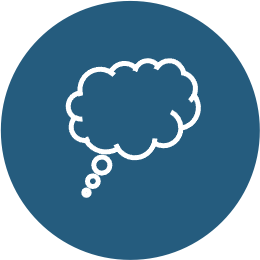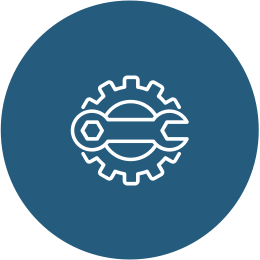Learning Methodologies and Activities
We use a variety of learning methodologies and activities to provide rich learning experiences.
Our approach
We draw on a range of adult learning theories in our learning design. Our approach to instructional design is driven by the concept of inquiry-based discovery learning, which requires learners to make connections to previous knowledge, bring their own questions to learning, investigate and critically reflect on concepts and design ways to try out their ideas.
To maximise learner engagement and transfer of learning, we design programs that offer both formal and informal learning opportunities.
Our top learning methodologies and activities
We’ve listed the top learning methodologies and activities that we use to design engaging, effective and efficient learning solutions.

Brainstorming
Benefits
Brainstorming is used to generate ideas and creative solutions. It provides an open environment for learners to share their thoughts and opinions.
Application
Think-Pair-Share is a form of brainstorming that can be used for a variety of topics. The facilitator provides a prompt which may be a question, statement or problem.
Learners then:
- Think: Individually reflect on the prompt
- Pair: Complete pair/group activity to discuss ideas, research the prompt or solve the problem
- Share: Learners share their thoughts and ideas with the whole group

Case studies
Benefits
Case studies are used to contextualize content. They show the application of a concept using a real-life example.
We use both analytical and problem-oriented case studies, depending on the skills we are targeting.
An analytical case study scenario is analysed in order to try to establish what happened and why – it is not necessary to identify problems or suggest solutions.
A problem-oriented case study scenario is analysed to identify the major problems that exist, and to suggest solutions to the problems identified.
Application
You may incorporate case studies when you would like learners to:
- Be able to integrate theory and practice
- Use critical analysis and evaluation skills
- Step through a story or situation, evaluate the issues and take logical and educated steps towards effective decision-making
When developing a case study, consider the following:
- Case study scenarios tell a story – they set out a situation or actual event
- Provide clear instructions to outline what is required of the participants to complete the case study
- Base your case study scenario on something that is real or something that the participants are likely to face in their roles

Debates
Benefits
Debate allows learners to challenge ideas and explore difficult positions in a safe context. It combats passivity by actively involving learners. It fosters teamwork, critical thinking and in-depth study of a topic.
Application
To hold a debate:
- Present a statement.
- Divide the group into two: For and Against.
- Explain the timings and order of speakers (example below).
- Present the criteria (e.g. strength of argument, relevance, delivery).
- Provide time for each group to research the topic and form their arguments.
- Commence the debate.
- Tally up scores, provide feedback and announce the winner.
Dividing the group in four, and providing each of the two groups with separate topics, allows two groups to remain as the audience and scoring group.

Self-paced extension activities
Benefits
We all learn at different paces. It is important that all learners are challenged in order to maintain engagement. Extension activities provide opportunities for learners to consolidate, extend and refine their knowledge, understanding and skills.
Application
Extension activities may be individual or group-based. They should focus on higher-order thinking skills – use Bloom’s Taxonomy to develop activities that involve ‘analysing’, ‘evaluating’ and ‘creating’.

Problem-based learning
Benefits
Problem-based learning is a learning strategy that uses open-ended problems that reflect real-world problems. This contextualises concepts and allows learners to apply their new insights in an authentic way.
Learners develop:
- Metacognitive skills
- Critical thinking skills
- Problem-solving skills
- Self-direction and autonomy
- Independence/collaborative skills
- Resourcefulness
- Innovation and creativity
There are four elements to problem based learning:
- Non-linear: Learners work in multiple directions and explore diverse avenues, theories, ideas and solutions.
- Authentic: Use real-world, relevant problems that are meaningful to participants.
- Guide and scaffold: Steer learners in the right direction using prompting questions and by providing resources.
- Personalised: Personalise learning, connecting with learner individual styles and creativity. Provide opportunity for extension.
Application
The Problem Based Learning Model involves the following steps:
- Develop problem: Design a problem that reflects the learning objectives and the real world. Ensure it is complex enough to sustain inquiry for the desired duration.
- Activate existing knowledge: Identify what learners do know. Activate their existing knowledge and understanding to prep learning.
- Identify required knowledge: Prompt learners to realise what they don’t know and what they need to know. This will inform their research.
- Research: Experimenting, searching the web, watching videos, emailing experts, reading texts, viewing images, listening to podcasts, stories or speakers, or working through a trial and error process.
- Critically analyse: Review, analyse and evaluate information. Assess the validity and reliability of information and sources.
- Reflect and compare: Reflect on multiple perspectives. Compare initial ideas/beliefs to new ideas/beliefs. Reflect on growth in understanding and skills.
- Share solution: Learners may share their solution/s through presentations, written pieces, graphic organisers, video or other means.
- Assess: Use multifaceted assessment strategies to evaluate learners understanding and skills.

Critical reflection
Benefits
Critical reflection helps to strengthen higher-order thinking skills, develop deeper understandings and make sense of experiences. It asks us to reflect on what happened, how we responded and what we would do differently next time.
It helps to build self-awareness, determine our strengths and weaknesses, and helps to facilitate professional growth.
Application
Reflective practice is often an individual exercise.
In its simplest form, critical reflection can be broken down into five high-level questions:
- What happened?
- How did you respond? What did you think/say/do/feel?
- What was the outcome?
- Can you do anything now to create a better outcome?
- What have you learned? What would you do differently next time?
This is also a useful embedding activity. Learners routinely use a journal to reflect on recent/challenging experiences, and discuss their learnings with their coach, mentor or learning buddy.

Skills practice
Benefits
Skills practice provides opportunities for learners to develop and refine skills.
Application
Use the ‘Show me, Help me, Let me do it’ process.
- Show me: Demonstrate how to complete the task.
- Help me: Support the learner in completing the task. Talk them through it.
- Let me do it: The learner completes the task independently.
Once the learner is confident in completing the task independently, extend their skill by asking them to apply it in different contexts. Remember to provide encouragement and corrective feedback, where required.

Critical incident analysis
Benefits
Critical incident analysis is used to facilitate reflective practice and is often used in high-risk industries.
Critical incident analysis provides an opportunity to learn from other past mistakes and prevents similar incidents from occurring again. It also shows evidence of the importance of the content you are teaching, and workplace policies and procedures.
Application
Present a critical incident relevant to the content. Analyse the situation and circumstances surrounding the incident, the cause of the incident, contributing factors, the actions of people involved in the incident, and the outcome. Seek to identify how the incident could have been prevented, what has changed in order to prevent the incident from occurring again, and how practice could be improved.
Incidents can be found at WorkSafe BC and Australian Transport Safety Bureau (ATSB).

Action planning
Benefits
The 70:20:10 model suggests that 90% of learning occurs outside of formal training. Action planning is an embedding strategy that helps to extend, deepen and refine the knowledge, understanding and skills developed in the workshop or training program. Action planning also supports the transfer of learning into the workplace.
Application
There are various ways to action plan. One example is to create a flip chart for each of the program’s key topics or concepts, and stick them around the room. Learners complete a gallery walk to brainstorm ideas on how to bring these to life. Review the ideas as a group. Each leaner then selects three actions that they will focus on, and add them to their action plan.

Simulation
Benefits
Through simulations, learners:
- Practice skills
- Develop a deeper understanding of concepts
- Receive immediate feedback
- Experience direct consequences and results in a safe environment
Software simulations provide a risk-free testing environment/sandpit for learners to actively develop and apply skills.
Simulations contextualise learning, illustrate issues and promote the understanding of group dynamics. It provides realistic examples of behaviours and practices required in a particular role.
Simulations provide opportunities to apply knowledge, practice skills, see other people’s perspectives and illustrate issues.
Application
A simulation could be last a few minutes or for the duration of the program.
For program-long simulations, group participants and assign a different role to each member. Over the program, participants complete activities in their role.
Before you begin, identify the knowledge, attitude or skills that you would like participants to develop or apply. The simulations should be shaped around these elements. For simulations that focus on:
- Knowledge acquisition, learners will be observing, analysing and assimilating their new insights
- Attitude, learners will experience emotions and share how they felt in their role
- Skills, learners will apply what they have learned, reflect on their performance and receive feedback

Coaching, mentoring and buddying
Benefits
Coaches support learners in goal setting and challenge them to grow to reach their potential.
Mentors offer guidance and advice in the workplace.
Buddies are fellow learners that encourage one another and hold each other accountable. They discuss embedding activities and share learning experiences which help to broaden their understanding of the topic by learning from someone else’s perspective. Buddies provide each learner with someone to contact when they require support, or need someone to bounce ideas off.
Application
Always ensure that coaches and mentors are engaged early on in the program. They should have a clear understanding of the program’s learning outcomes and the role they will play in the process.
You could provide mentors or coaches with a kit of embedding activities to facilitate with their team members after the program.
Buddies are often developed during or towards the end of the program. Ensure you clearly articulate the purpose of the buddy, when they are to meet, how, and what they are to discuss. For example, if learners are to write weekly entries into their learning journal, you may instruct buddies to meet each Friday afternoon in a meeting room for 30 min to share and discuss their learnings. Make sure you provide specific questions or discussion points to keep the conversation (and learning!) on track and aligned to specific outcomes.
FAQs
What is a learning methodology?
Learning methodology refers to methods, principles and practices used to deliver effective learning.
What are examples of learning activities?
Examples of learning methodologies and activities include:
- Brainstorming
- Case studies
- Debates
- Self-paced extension activities
- Problem-based learning
- Critical reflection
- Critical incident analysis
- Action-planning
- Simulation
- Coaching, mentoring and buddying
What are active learning methodologies?
Active learning methodologies require participants to actively participate in their learning through case studies, debates, critical reflection, simulations, skills practice and other methods.
What are the different teaching/learning methodologies?
Teaching and learning methodologies include:
- Problem-based learning
- Flipped classroom
- Inquiry-based learning
- Project-based learning
- Differentiated learning
- Game-based learning
- Experiential learning
- Shared learning
How do you create a learning activity?
To create a learning activity:
- Begin by identifying the purpose of the activity and how it links to the learning outcomes.
- Design the introduction for the activity and how it will be positioned.
- Draw on adult learning principles to structure the activity, ensuring it strongly achieves its purpose.
- Create debrief questions to ensure learners developed the intended understanding and skills, and make clear links between the activity and program’s learning outcomes.
Relevant blog articles:
- The Many (Many, Many!) Instructional Design Models
- The Learning Benefits of Video and Multimedia
- Problem Based Learning (PBL)
- Applying Problem Based Learning (PBL)
- The 70:20:10 Learning Model
- Embedding Activities in Learning Design: Why Leaders Matter



